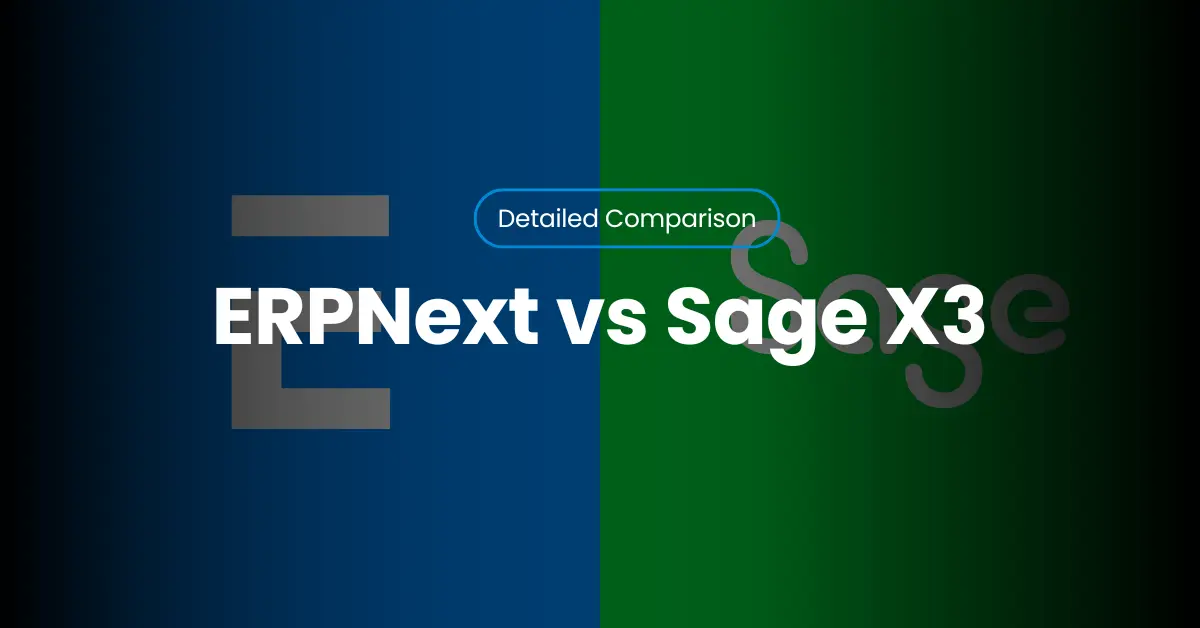In 2025, choosing the right ERP system is more than a technology decision — it’s a strategic move that shapes efficiency, accuracy, and growth. Businesses today juggle complex operations across finance, inventory, CRM, and manufacturing, making automation and integration essential. Without a robust ERP, teams risk scattered data, duplicated efforts, and slower decision-making.
ERPNext and Sage X3 are two solutions frequently considered by business owners and IT managers. One represents a flexible open-source approach, the other a feature-rich proprietary system. This ERP comparison provides practical insights to help you decide which system aligns with your business processes, budget, and growth plans in 2025.
Overview: ERPNext and Sage X3
ERPNext:
ERPNext has emerged as a compelling open-source ERP solution built on the Frappe framework. Its modular design allows businesses to manage accounting, HR, inventory, manufacturing, and CRM within a single platform. For small to medium-sized businesses, ERPNext provides both affordability and flexibility, letting you scale modules as operations grow.
Key advantages include:
- Cost-effective deployment with free Community edition or low-cost cloud subscription
- Rapid customization and integration via Frappe framework
- Streamlined workflows for finance, manufacturing, and HR
- Active global community support and frequent feature updates
For example, a mid-sized distribution company can implement ERPNext for inventory tracking and order automation within weeks, avoiding the high licensing fees typical of proprietary ERP systems.
Sage X3:
Sage X3, on the other hand, is a proprietary ERP platform designed for enterprise-scale operations. It offers comprehensive modules for financial management, manufacturing, supply chain, and advanced analytics. Its structured design makes it ideal for companies with complex multi-entity operations, multi-currency requirements, and stringent compliance needs.
Strengths include:
- Robust financial management for multi-country and multi-currency operations
- Deep manufacturing and SCM capabilities for complex production environments
- Extensive reporting and business intelligence tools
- Support from Sage’s global partner network
That said, implementation timelines can be longer and licensing fees are significantly higher. Businesses often invest heavily in consulting and technical resources to fully utilize Sage X3’s enterprise-grade capabilities.
Head-to-Head Comparison:
Before diving into features, it helps to see how ERPNext and Sage X3 compare across high-level criteria. Here’s a concise view for quick evaluation:
| Feature Area | ERPNext | Sage X3 |
| Type | Open-source (Frappe framework) | Proprietary software by Sage |
| Deployment | Cloud or on-premise | Primarily on-premise, cloud available |
| Target Market | SMBs, mid-market enterprises | Mid-market and large enterprises |
| Licensing | Free Community / Low subscription | High per-user annual fees |
| Core Strength | Flexibility, customization | Enterprise-grade features and scalability |
Takeaway: ERPNext excels in affordability and modular flexibility, making it ideal for growing SMBs. Sage X3 is built for large-scale, complex operations, but comes with higher cost and implementation complexity.
Feature Comparison:
Let's compare the features of both ERPNext and Sage X3 to check which is best fit for your business:
Manufacturing and SCM:
Manufacturing and supply chain management (SCM) are often the heart of an ERP system for mid-market and enterprise businesses. ERPNext offers streamlined production planning, BOM management, and shop floor control, making it ideal for SMBs that need efficiency without overcomplicating processes. Real-time inventory tracking ensures minimal stockouts, while automated work orders keep production aligned with demand forecasts.
Sage X3 goes deeper for larger operations, providing multi-site production scheduling, advanced MRP, and complex vendor collaboration. For example, a global manufacturer managing multiple factories across continents benefits from Sage X3’s granular control over procurement, logistics, and regulatory compliance.
Key comparison points:
- ERPNext: Simple BOM and production scheduling, ideal for growing businesses
- Sage X3: Advanced MRP, multi-location supply chain visibility
- Both support demand forecasting and inventory optimization, but Sage X3 handles complexity at scale
Finance and Accounting:
Financial management is often the backbone of ERP adoption. ERPNext provides full accounting capabilities, including automated invoicing, multi-currency support, and customizable financial reports. Its dashboards offer clear visibility for CFOs and business owners, helping them make faster, data-driven decisions.
Sage X3 elevates financial operations with advanced consolidation, regulatory compliance, and intercompany transaction management. Enterprises managing multiple subsidiaries or international operations often find Sage X3 indispensable for audit-ready reporting.
Example: A mid-market distributor managing both USD and EUR accounts may find ERPNext sufficient for daily operations. However, a multinational with complex tax structures and multi-entity reporting will likely benefit more from Sage X3.
Pricing and Total Cost of Ownership (TCO)
Understanding the total cost of ownership (TCO) is crucial when comparing ERP systems. ERPNext pricing is known for its cost-effectiveness. Businesses can choose the free Community edition or a cloud subscription starting around $20 per user/month, keeping both initial and ongoing costs low.
Sage X3 pricing is significantly higher, with licensing fees ranging from $5,000–$10,000 per user/year, not including implementation, customization, and ongoing support. Over a 5-year period, the TCO of Sage X3 can be 3–5x higher than ERPNext, even with enterprise-level capabilities.
Pricing snapshot:
| Cost Category | ERPNext | Sage X3 |
| Licensing | Free or low subscription | High per-user annual fees |
| Implementation | Moderate | Expensive, consultant-heavy |
| Maintenance | Minimal | High recurring cost |
| 5-Year TCO | Low | 3–5x higher |
Takeaway: For businesses seeking ROI and scalability without high upfront costs, ERPNext offers a clear advantage, particularly for SMBs and mid-market enterprises.
Customization and Flexibility: Open-Source vs Proprietary
ERPNext’s open-source framework allows businesses to tailor workflows, add modules, and integrate with external tools without vendor lock-in. Companies can customize dashboards, reports, or even core modules to match unique business processes.
Sage X3 offers flexibility but within a structured, proprietary environment. Customization often requires specialized consultants, increasing time and cost.
Practical examples of customization:
- ERPNext: Adding a custom manufacturing workflow for a niche product line
- ERPNext: Integrating CRM data directly into inventory planning
- Sage X3: Extending standard MRP reports for multi-site compliance
In most cases, ERPNext empowers in-house teams to adapt processes quickly, whereas Sage X3 may require external support for significant changes.
Implementation and Ease of Use
ERP adoption often falters due to complex implementation and steep learning curves. ERPNext typically goes live faster, often within 2–4 months for SMBs, thanks to intuitive user interfaces (UI) and simple configuration. Staff can adopt workflows quickly with minimal training.
Sage X3, with its advanced capabilities, may require 6–12 months for implementation. Multi-site deployments, complex configuration, and the need for specialized consultants extend both time and cost.
Implementation tips:
- ERPNext: Start small, deploy core modules first, then expand
- Sage X3: Plan for extended training and change management
Pros and Cons of ERPNext and Sage X3:
Below are the advantages and disadvantages of ERPNext and Sage X3:
ERPNext:
ERPNext offers a flexible and cost-effective ERP solution for SMBs and mid-market enterprises.
Pros:
- Open-source and affordable, reducing upfront and long-term costs
- Highly customizable modules for finance, manufacturing, HR, and CRM
- Intuitive user interface (UI) accelerates user adoption
- Active community and regular updates
Cons:
- May lack advanced compliance and regulatory features for large enterprises
- Deep customization may require internal technical skills
- Some BI and reporting features are simpler than enterprise alternatives
Example: A growing distributor can quickly add custom workflows for inventory and sales without relying heavily on external consultants, saving time and money.
Sage X3:
Sage X3 is tailored for enterprise-scale operations but comes with higher costs and complexity.
Pros:
- Advanced financial management and multi-entity reporting
- Deep manufacturing and supply chain management capabilities
- Reliable enterprise support and global partner network
Cons:
- High licensing fees and implementation costs
- Slower deployment due to complex setup
- Limited flexibility for in-house customization
Insight: Sage X3 is ideal for large businesses needing compliance, multi-site operations, and deep analytics. For smaller or mid-market enterprises, ERPNext may deliver faster ROI.
Why Many Businesses Are Switching from Sage X3 to ERPNext:
Businesses increasingly consider ERPNext as a practical alternative due to:
- Lower operational costs and flexible subscription models
- Faster updates and feature rollout without heavy reliance on consultants
- Simpler cloud deployment, enabling remote teams and data accessibility
- Customizable workflows, reducing dependency on vendor services
Companies transitioning from Sage X3 often find ERPNext easier to adopt across multiple departments, while maintaining control over business processes. ERPNext Implementation partners like Infintrix Technologies help ensure smooth migration with minimal downtime.
Migration Guide: Moving from Sage X3 to ERPNext
Migrating to ERPNext can be straightforward with the right planning:
5-Step Migration Roadmap:
- Assessment: Map existing Sage X3 workflows and data
- Data Migration: Cleanse and import critical data into ERPNext
- Configuration: Set up core modules and custom workflows
- Testing & Training: Validate processes and train end-users
- Go-Live & Support: Monitor operations and resolve early issues
Tip: Leveraging experienced ERPNext implementation partners ensures data integrity and smooth adoption.
ERPNext vs Sage X3: Which One Fits Your Business Best?
Summary:
- Startups & SMBs: ERPNext offers affordability, modular scalability, and fast deployment.
- Mid-market enterprises: ERPNext balances cost with flexibility, particularly for manufacturing and distribution companies.
- Large enterprises: Sage X3 is better suited for multi-location operations, advanced SCM, and regulatory compliance.
Verdict: The “best” ERP depends on business size, growth plans, complexity, and budget. ERPNext provides flexibility and ROI for growing companies, while Sage X3 serves large enterprises with complex operations.
Conclusion: Making the Smart ERP Choice
Choosing the right ERP is about aligning the system with your business goals. ERPNext delivers flexibility, rapid implementation, and lower total cost of ownership, while Sage X3 offers enterprise-grade depth and compliance. With guidance from experienced partners like Infintrix Technologies, businesses can maximize ERPNext’s potential—from setup to long-term growth—without the overhead of high licensing fees or complex deployment.
Frequently Asked Questions:
Q:1 Is ERPNext a reliable alternative to Sage X3?
Yes, many SMBs successfully replace Sage X3 with ERPNext, reducing costs while maintaining key business functionality.
Q:2 Can Sage X3 users migrate data to ERPNext easily?
With structured planning and expert support, migration is straightforward, minimizing downtime.
Q:3 Which ERP provides better ROI in 2025?
ERPNext typically delivers faster ROI for small to mid-market businesses due to lower costs and faster deployment.
Q:4 How long does ERPNext take to implement compared to Sage X3?
ERPNext implementations often complete within 2–4 months, while Sage X3 can take 6–12 months.
Q:5 Does ERPNext support manufacturing and inventory automation like Sage X3?
Yes, for SMBs and mid-market companies, ERPNext provides robust MRP and inventory tools; Sage X3 supports more complex, large-scale operations.
Related Articles:
Frappe vs ERPNext – Which One to Implement First 2025
ERPNext vs Odoo vs SAP Business One: A Quick ERP Comparison for Manufacturers
ERPNext vs QuickBooks: Which Is Better for Your Business in 2025?
ERPNext vs Tally: Which One Is Right for Your Business in 2025?
ERPNext vs Dolibarr: Best ERP for SMEs in 2025?
ERPNext or SAP: Which ERP Software Should Your Business Invest In?

